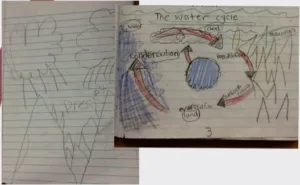I am often questioned about the instructional benefits, based on available research, that can emerge from employing 3D, VR, and HD visualization technologies in schools and colleges. “What is the difference some of these technologies make in learning?”they wonder. “How effective are these technologies with young learners?” they ask.

Last year I told the story of Holli Hillman, a 4th grade teacher in the St. Francis Schools (Minnesota), who demonstrated a palpable level of learning outcomes to the leaders who were funding her innovative classroom visualization efforts.
At that time, Ms. Hillman decided to conduct a focused action-research effort, showing before and after examples of actual student work. (“Action research”, as it is called, is informal research conducted in live classrooms by practicing teachers. It can provide very useful empirical insight about learning with technology.) In her previous study, Ms. Hillman used stereo 3D projectors, along with vivid science simulation content in her fourth grade classroom over a several year period. Positive student “before and after” results were strongly in evidence:
Before stereo 3D visualization, using traditional materials
After stereo 3D instruction
Before stereo 3D visualization, and after
Before stereo 3D visualization, using traditional materials
After stereo 3D instruction
Hillman summarized the learning benefits of 3D visualization in learning in a conference presentation using these two frames:
Although Hillman’s action research came much later, her evidence echoed the UK LiFE studies findings on stereoscopic 3D student model creation by Anne Bamford [Bamford, Anne (2011) “LiFE: Learning in Future Education. Evaluation of Innovations in Emerging Learning Technologies”], as demonstrated by the final student products in this video.
Fast Forward
Now fast forward with me to another and even more current project. This effort focuses on the use of zSpace “desktop virtual reality“ visualization technologies at higher grade levels–in both sixth and ninth grade science classrooms–and employs a more rigorous model for analysis. In a research paper presented for the Association for Science Teacher Education (ASTE) National Conference, Des Moines, IA. [Hite, R., Jones, M. G., Childers, G., Ennes, M., Chesnutt, K., Pereyra, M., Cayton, E., & Stanley, R. (2017, January). The Utility of 3-D, Haptic-Enabled, Virtual Reality for Learning Complex Biological Systems: Students Understanding of the Human Heart.], the results are fascinatingly similar to the previous studies. Take a look for yourself (although you may need to zoom in to see the students’ details):
What can we see? The parallels continue. The results are striking. Over time, among different teachers, between differing grade levels, and across different geographic locations, 3D, VR, HD (and likely AR/MR) instruction appears to help children look deeper, observe more carefully, and learn their lessons more thoroughly and thoughtfully. It is possible that visualization technologies assist us in ushering deeper meaning directly into the “mind’s eye” of a young learner’s understanding. Certainly, it also means that educators need to take VR more seriously than they have in the past. Who would’ve known?–Len Scrogan

